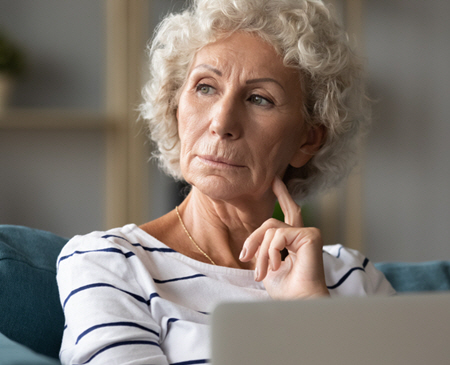 This is different from traditional talk therapy…
This is different from traditional talk therapy…
Talking is good for so many things: working out conflicts, getting information, or telling a story or anecdote.
Traditionally, talking has made up a large portion of therapeutic practice.
But sometimes, talking is not so helpful… like when you’d rather avoid the subject or when things are awkward to talk about.
OCD can cause us to worry about thoughts that pop into our heads, like thoughts of harming others or “bad kinds of sex.” And talking about them just seems to make the shame worse.
One thing is certain: There is nothing new under the sun.
Our troubles (and the thoughts and images in our heads) are common to all. Honest!
Thoughts, at the end of the day, are just neurons firing in our brain. Their content can come from all sorts of places and are often very random.
Most people have experienced a common fleeting thought of driving off a cliff when driving in the mountains. This is a scary thought, but it doesn’t mean that you want to do that or that that is imminently about to happen. It is just a thought…
Other common thoughts can occur around themes of harm to self or others, bad kinds of sexual thoughts, contamination worries from all sorts of sources, illness and somatic worries, responsibility concerns for those you love, and the list goes on.
Most of the time, we can let these thoughts just pass on by. Sometimes, though, they get lodged in our minds and don’t seem to go away.
 When those thoughts just won’t go away…
When those thoughts just won’t go away…
For people who don’t suffer from OCD, these distressing thoughts are able to resolve on their own and leave the mind quickly.
People with OCD have a “stickier” brain. Those thoughts that usually follow the random intrusive disturbing thought is, “Why am I thinking this?”, “What is wrong with me?”, “Is this something I want?”, and all manner of self-recrimination.
The hard part is that OCD does not respond to “regular” ways that we solve problems (as you have likely noticed).
We are not able to…
- Talk ourselves out of these fears;
- Use logic or problem-solving skills against them;
- Find any reassurance to make us feel better, either from ourselves or our loved ones;
- Ignore these thoughts and move on!
And that can leave us feeling so disempowered and helpless against our own brains!
There is help, though, and OCD is treatable and manageable through Exposure and Response Prevention Therapy!
“Exposure Therapy” to the rescue!
Exposure therapy is all about “un-sticking” those thoughts!
It is like “Goop” that my dad had out in his garage. Goop was a soap that would take anything off your hands, like grease and oil from working on cars, etc. This therapy is “Goop” for the brain!
We can never stop thoughts (or feelings) from coming. After all, they are a natural part of being human. But we can work so that they don’t “hang around” and torture us.
Let me explain why exposure therapy works…
Exposure therapy has been shown to be effective against persistent worry and reoccurring fears, which is what happens in obsessive-compulsive and other anxiety disorders. The theory behind its effectiveness has to do with how we learn from our environment and our experiences.
We are designed to take negative experiences and learn from them in order to protect ourselves in the future. For some people, however, their brains attach too high of a threat level to thoughts and experiences. This permits the protection system to get triggered too easily.
Through exposure therapy, we do experiments that offer new opportunities for learning, which retrains the brain to have a more proper setting for dangers we might face.
 Here’s what we’ll do…
Here’s what we’ll do…
During exposure therapy, we will emphasize that there is no shame or blame… just a chance to learn a different way to interact with ourselves and this world we all share.
I understand that this might feel daunting and mystifying at this point, but let me break it down for you…
We’ll start by talking about what types of worries and rituals you are currently experiencing. This could be worries about harming your loved ones or yourself, not pleasing others or God, not being perfect, bad sexual thoughts, just to name a few.
The rituals can be things like cleaning rituals, hoarding rituals, checking rituals, mental rituals like counting and using words to counteract negative thoughts, or avoidance rituals and escapism from the fearful situations and thoughts.
We’ll then design exposure experiments to test these worries…
…without using any of your current rituals or habits to help with the anxiety. This is the active part of what we’ll do together.
I’ll be up front and tell you that this is the hard part, but the good news is that you are always in control of your therapy! Leaning into your fears, at first, feels very scary. We do this by either actually doing the thing that you are afraid to do (only if it is a safe thing!) or using our imaginations to get at the more scary thoughts that are abstract, like “I am going to die alone.”
Not doing your compulsions feels very bad at first, but with practice it gets easier. We may touch surfaces around my office that “feel contaminated,” and then just sit with that feeling without washing our hands until the disturbing feeling subsides. And it will. Through these exposure experiments, you are actively learning that 1. You can tolerate the feelings, and 2. That nothing bad actually does happen when you lean into your fears and don’t do your compulsions.
Once you get the hang of how the experiments work and you have had some success working on “low hanging fruit” (the things that aren’t too distressing), we will start planning work that you can do between sessions. Again, this is at your discretion, and I’ll check in with you at the start of our sessions to see how your efforts have been progressing.
The more you choose to lean in and do exposure work, the easier it becomes and the less your OCD will bother you. You will gradually grow more and more in charge of your brain.
Always remember: The work we will do together has a natural flow and is always at your pace.
After you start seeing success as a result of exposure therapy…
We may discuss other, subtler ways that OCD and/or anxiety has affected you.
OCD can often leave people who suffer from it feeling bad about themselves. We discuss the source of worth and self-esteem. Sometimes there has been trauma in your life that OCD uses to bring back to you and cause you distress.
I am trained in EMDR, which is the evidence-based therapy that effectively processes and treats trauma. Often, in treating OCD, Gestalt therapy can have good results with the relational and identity issues that come up. Gestalt is about finding what you really think and feel, and it promotes self-validation and acceptance which takes power away from OCD.
Let’s get started on building a new life…
… one free of those mean OCD and anxiety monsters! Just like the old whack-a-mole game, we’ll keep whacking at them until they’re no longer bothering you.
When you graduate from therapy, you’ll have the experience and tools to move forward. You’ll feel prepared when OCD and/or anxiety show up at your doorstep again. This can happen during times of change or stress, but you will be on the lookout!
Yes, therapy is work, but it doesn’t have to be confusing or scary… and your peace and happiness are worth it.
Call me today to discuss the details and to get started on your journey to freedom! (970) 541-2862

